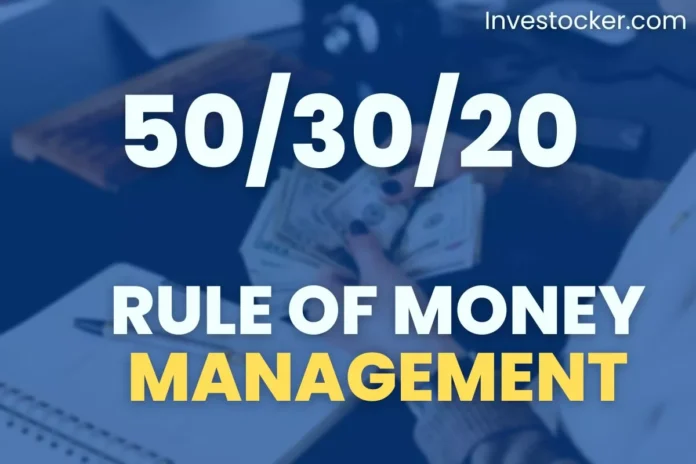“Why Can’t I Save More?” is a question I often hear when it comes to budgeting. And I get it. Suppose you don’t have the proper framework to manage your money. In that case, you probably live paycheck to paycheck, never able to progress on your financial dreams. It sucks.
But what if there was a simple system for managing your money that a child could understand and would provide you with a long-lasting, effective way to budget? And avoid overspending, and build up your savings – all in a fraction of the time. You may think.
Also Read: 3 Books To Learn How To Get Rich & Become Wealthy
The 50/30/20 Rule Of Money Management
Well, today, you’re in luck. In this article, we’re going to talk about the “50/30/20 Rule of Money Management.” Are you ready? Let’s go!
What Does the 50/30/20 Rule Mean?
First, let’s talk about what the 50/30/20 Rule means. Let’s pretend there’s a pie in front of us, and half of it, or 50%, represents your needs. Again, this is about making a budget, knowing where your money is going, and making the best personal budget portfolio. So you need 50%.
Let’s say that you will spend 30% of this money on what you want, and the other 20% will go to savings or paying off debt.
So, now that you have a clear picture, let’s break down each of these numbers and give you an example of each so you can use them to figure out how your finances are doing.
Also Read: 18 Warren Buffett Frugal Living Tips To Save Money
Net Income Explained
Remember that we are working with net income, which is the amount of money left over after taxes. So, let’s say your gross pay is $50,000 yearly, but after taxes, you only look at a different number. We’re using that amount of money after taxes. Half of your income after taxes should cover your most essential costs.
What To Do With The 50% Of Your Income?
So, what are some things that can be included in the “50% needs?” Simply put, needs are costs that you can’t avoid. They include payments for everything you need to live and can’t do without. Needs include a monthly rent payment, bills for electricity and gas, essential food items, and health insurance. (God forbid anything wrong to happen to you). I would say that having health insurance is a must.
So, I think of a need as something you really can’t live without or something that would cause you a lot of trouble if you didn’t have it. So, keep this in mind when you make a budget for your needs. This budget may be different for each person. If you find that your needs take up more than half of your take-home pay, you might be able to make some changes to cut back on those costs.
Also Read: Top 15 Best Frugal Living Strategies To Save Money
It could be as easy as switching to a different energy provider or finding new ways to save money while grocery shopping. It could also mean making more significant changes in your life, like looking for a cheaper place to live.
What To Do With The 30% Of Your Income?
The next thing that makes sense is what you want, which is 30% of your net income. I think this is where most Americans have trouble telling the difference between what they want and what they need.
Difference Between Wants & Needs?
Wants are things you choose to spend your money on, even though you could live without them if you had to. Some of these are going out to eat, buying clothes, joining a gym, paying for entertainment like Netflix, and buying groceries.
If you’re unsure if you want or need something, ask yourself, “Could I live without this?” If the answer is yes, then that’s probably a want.
Also Read: 6 Expensive Things You Should Avoid Buying Right Now
Note: Following the "50/30/20 Rule" does not mean you cannot enjoy your life. It just means being more careful with your money by figuring out where you're wasting money in your budget.
What To Do With 20% Of Your Net Income?
So let’s talk about the last 20%. I know that a lot of this sounds like common sense. Still, until you write it all down and figure out where all your money goes, it’s easy for your wants to creep into your needs until they both overflow, and you’re in monthly debt.
Now that we’ve talked about debt let’s talk about savings. It is where you should put the last 20% of your money. I like to save enough money to cover my living costs for six to twelve months. So, if your needs and a few wants add up to, say, $2,000 a month for your whole family, you know you need to save between $12,000 and $24,000 in an emergency fund.
I know that sounds like a lot of money, but if you only have one or two income earners in your family and one, or both of you, get laid off, this buffer can save your butt.
Also Read: Best 5 Steps To Build Wealth in 2022
After you’ve filled up your buffer, I’d use that money first to pay off any debts you have, then use it for your future investments.
How To Use 50/30/20 Rule Of Money In Life?
So, how do you use the 50/30/20 Rule in real life? To use this simple budgeting rule, you’ll need to figure out your income and divide it into the 50/30/20 ratio. Here are the steps:
- First, calculate your after-tax income. Then, categorize your spending for the past month.
- And lastly, evaluate and adjust your spending to match the 50/30/20 Rule.
Budgeting doesn’t need to be complicated, nor should it take hours out of your day. With only three major categories to track, you can save yourself the time and stress of digging into the details every time you spend. And that is something the 50/30/20 Rule provides.
Also Read: How To Develop Investing Mindset For Teenagers?
Conclusion
Try the “50/30/20 Rule” out and see if it works for you and helps you move forward toward your financial dreams. My favorite part of the 50/30/20 Rule is the 20% that goes into your savings. Because to me, wealth isn’t so much about how much you make but about how much you save. Keeping a higher percentage of your income can fast-track your road to wealth.



